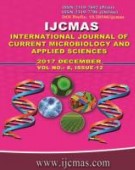


 National Academy of Agricultural Sciences (NAAS)
National Academy of Agricultural Sciences (NAAS)

|
PRINT ISSN : 2319-7692
Online ISSN : 2319-7706 Issues : 12 per year Publisher : Excellent Publishers Email : editorijcmas@gmail.com / submit@ijcmas.com Editor-in-chief: Dr.M.Prakash Index Copernicus ICV 2018: 95.39 NAAS RATING 2020: 5.38 |
An investigation was carried out to identify the extent of genetic divergence that exist for the yield and yield contributing characters of 25 genotypes of Khedha Bhaji (Amaranthus dubius Mart.) using Mahalanobis D2 analysis. Analysis of variance showed significant difference among the genotypes for most of the characters studied. The genotypes under study fell into 5 clusters. The distribution pattern indicated that the distribution pattern indicated that the maximum number of genotypes (7) was included in cluster (I) and (V) followed by cluster IV (6) and cluster II (4), and the minimum number was in cluster III (1). The intra-cluster distance varied from 0.000 to 3.157. The maximum intra cluster distance was shown by cluster I (3.157) followed by cluster IV (2.482), cluster II (2.390), cluster V (1.871) and cluster III (0.000), which indicate distance within the cluster. The characters like test weight of seed contributes highest (42.95%) to divergence followed by leaf length (17.11%), dry matter per cent (13.42%), plant height (12.75%), fibre content per cent (2.68), petiole length (1.34), number of leaf per plant (1%), root length (1%), yield kg per plot (1%) days to 50% flowering and duration (0.33%) contributed maximum towards genetic diversity. Hence these characters could be given due importance for selection of genotypes for further crop improvement programme.
 |
 |
 |
 |
 |